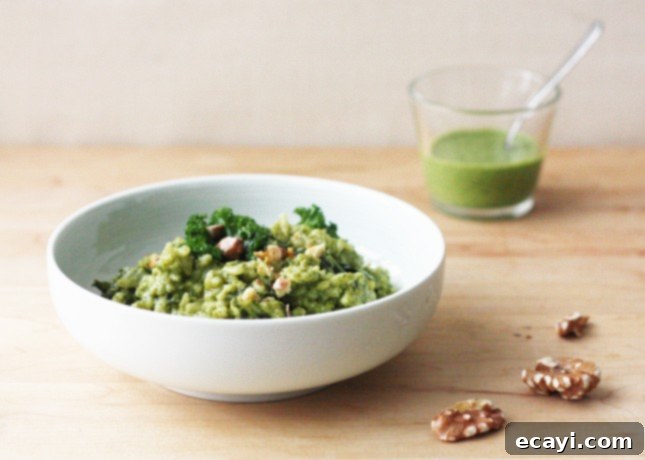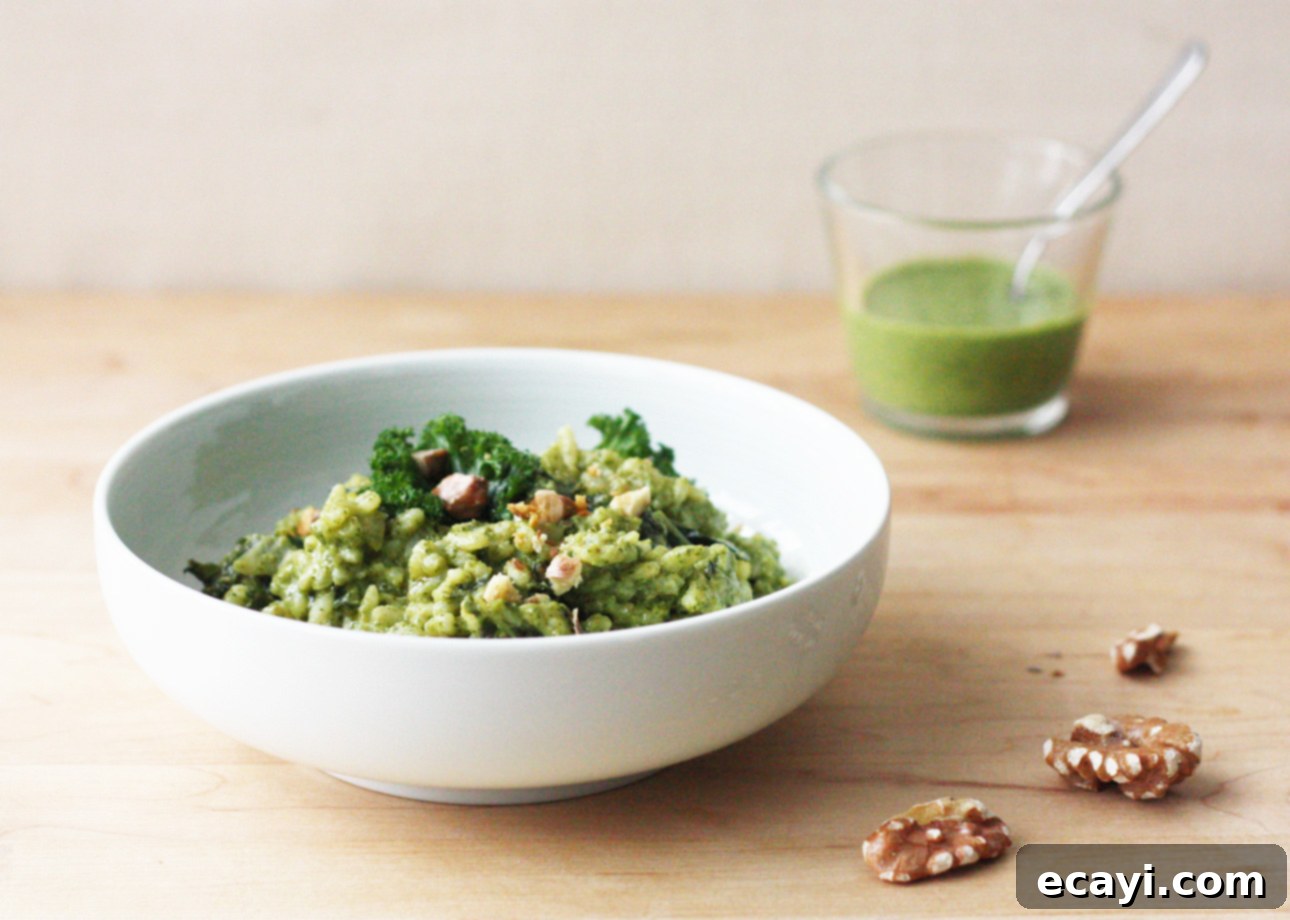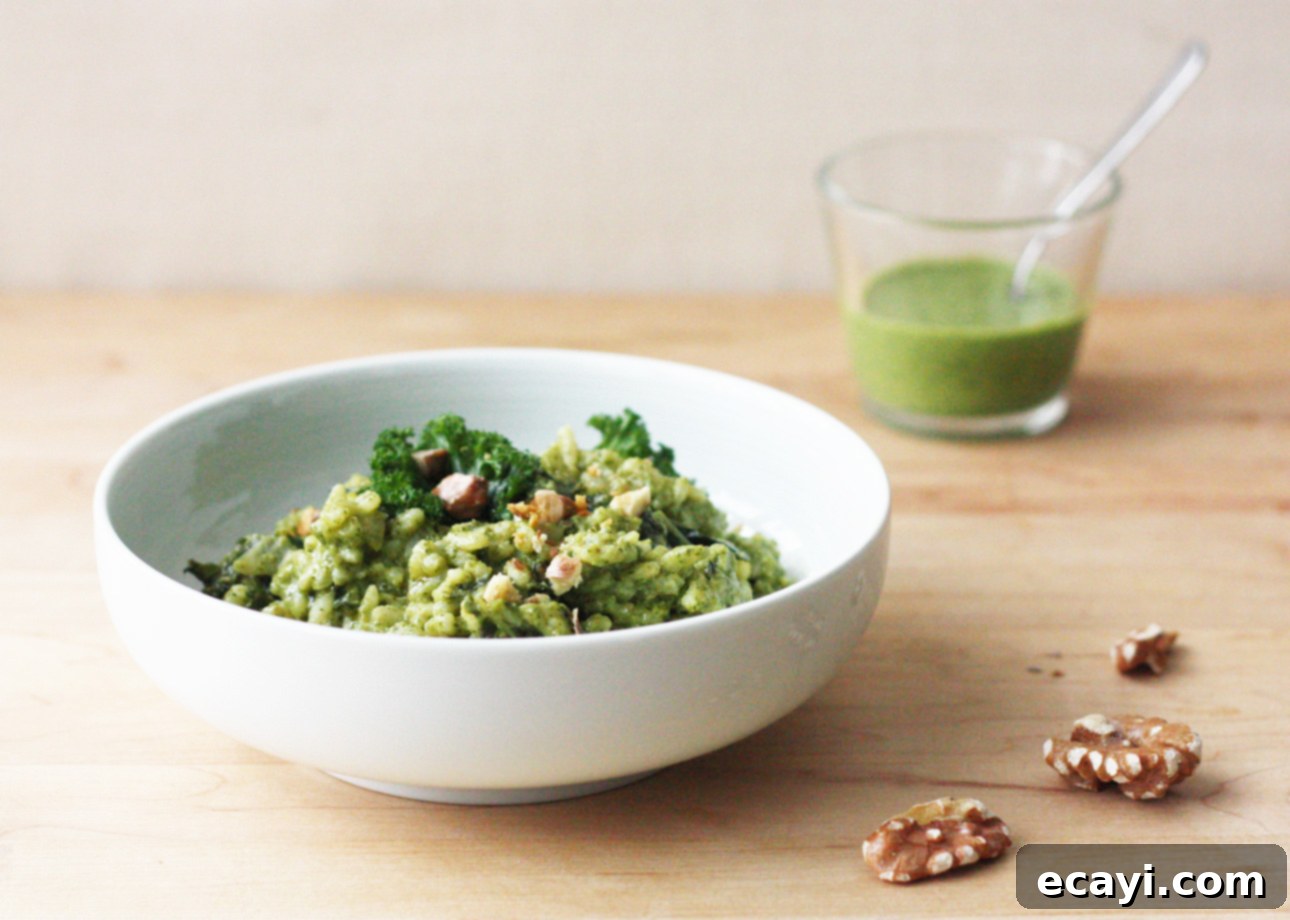Easy & Creamy Kale and Walnut Pesto Risotto: Your Ultimate Comfort Food Guide
Experience the ultimate comfort and culinary satisfaction with our easy-to-follow recipe for Kale and Walnut Pesto Risotto. This dish is a testament to how quick, light, and incredibly satisfying a homemade meal can be, without the fuss. Whether you’re a seasoned chef or a kitchen novice, this risotto will quickly become a cherished favorite. Its vibrant flavors and creamy texture make it a versatile choice: enjoy it simply, or elevate it by incorporating your favorite cooked meats and vegetables towards the end. A generous swirl of Parmesan cheese brings it all together, creating a dish that’s truly a delight to the senses. Forget the takeout; embrace the joy of creating something truly special in your own kitchen.

Debunking the Myth: Why Risotto is Easier Than You Think
For too long, risotto has suffered from an undeserved reputation as a fussy, time-consuming dish, requiring constant, vigilant stirring. This perception has led to well-intentioned, but ultimately misguided, innovations like “oven risotto.” Ironically, these attempts to simplify often add unnecessary steps or, worse, detract from the very essence that makes traditional stovetop risotto so incredibly delicious and rewarding. I almost overlooked this particular recipe for that very reason – the mention of an “oven risotto” concept, suggesting it’s a “self-sufficient” dish that doesn’t need your attention. Let me assure you, the magic of risotto lies not in avoiding the stove, but in the simple, rhythmic act of stirring, which is far from a chore.
The Problem with “Oven Risotto”
The concept of “oven risotto” fundamentally misunderstands the dish. Risotto’s signature creaminess isn’t just about the starch released from the rice; it’s also about the continuous emulsification of that starch with warm broth and a little fat, aided by gentle agitation. Baking risotto often results in grains that cook unevenly, lacking the velvety, flowing texture that defines a truly great risotto. Furthermore, many “oven risotto” recipes actually require significant stovetop prep – frying onions, toasting rice, deglazing with wine – before it even goes into the oven. So, what did you save? A few minutes of stirring? This approach defeats the purpose and strips away the interactive, sensory experience of making risotto from scratch. If you ever encounter an oven risotto recipe, I urge you to reconsider. The true beauty of risotto lies on the stovetop, offering control, superior texture, and a more engaging cooking experience that doesn’t demand constant attention but rather mindful engagement.
The True Joy of Stovetop Risotto: Simple, Quick, and Comforting
Let me convince you: traditional stovetop risotto is incredibly easy and surprisingly quick to make. It’s my go-to meal when I’m tired and craving something genuinely comforting. It’s adaptable, perfect for using up leftovers, and delivers a warm, creamy, cheesy spoonful of happiness every single time. All you truly need are basic ingredients like Arborio or Carnaroli rice, good quality chicken or vegetable stock, freshly grated Parmesan cheese, and about 20-25 minutes of your active cooking time. Most of that time, you’ll be casually stirring, perhaps sipping a glass of wine, catching up on a podcast, or even tackling a few dishes. You don’t need to be glued to the stove; occasional, rhythmic stirs are all it takes to achieve that coveted super-creamy texture and ensure the rice cooks evenly without sticking to the pan. This method allows you to witness the transformation of humble rice into a luxurious dish right before your eyes.
This process is not just about cooking; it’s about connecting with your food. Watching the rice slowly absorb the broth, swelling and transforming into a luscious, rich dish, is genuinely satisfying. The gentle bubbling, the fragrant steam, and the gradual thickening of the liquid all contribute to a meditative cooking experience. Once the risotto reaches its perfect al dente tenderness and creamy consistency, you can fold in cooked meats or vegetables if you wish, or keep it beautifully simple. A final stir of Parmesan cheese and a knob of butter, and your masterpiece is complete. There’s a profound sense of accomplishment that comes with creating such a delightful meal from scratch. Isn’t that far more rewarding than ordering takeout?
Why Kale and Walnut Pesto Risotto? A Symphony of Flavors and Textures
While the process of making risotto is straightforward, this particular Kale and Walnut Pesto Risotto elevates the experience with its fresh, vibrant flavors and satisfying textures. It’s a dish that feels sophisticated yet remains incredibly approachable. The pesto, made with earthy walnuts, pungent garlic, fresh parsley, and the distinctive slightly bitter notes of kale, offers a unique twist on the classic basil pesto. This combination not only provides an incredible depth of flavor but also infuses the risotto with a beautiful emerald hue and a wealth of nutrients. Kale, a powerhouse of vitamins and minerals, adds a healthy dimension, while the walnuts contribute heart-healthy fats and a delightful crunch.
The crunch of additional toasted walnuts on top adds a welcome textural contrast to the creamy rice, enhancing every bite. The kale, both integrated into the pesto and folded into the risotto itself, ensures a nutritious boost and a subtle, pleasant chewiness. This is a meal that truly nourishes the body and soul, offering a balanced profile of carbohydrates, healthy fats, and greens. The slight bitterness of the kale perfectly balances the richness of the Parmesan and the delicate sweetness of the cooked Arborio rice, creating a harmonious and addictive flavor profile that will leave you wanting more. Plus, making your own pesto means you control the ingredients, ensuring the freshest, most vibrant taste possible, free from artificial additives found in store-bought versions.
Crafting the Perfect Kale and Walnut Pesto
Making homemade pesto is a joyful and simple process, and this kale and walnut variation is no exception. While it adds an extra step to the overall dish, the reward is twofold: an incredibly fresh, flavorful pesto for your risotto, and often, some delicious leftovers to enjoy in other meals. To start, lightly toasting the walnuts is a crucial step; this process deepens their flavor, making them more aromatic and nutty, which pairs beautifully with the robust kale. A good food processor is your best friend here, quickly transforming the ingredients into a vibrant, aromatic paste. Ensure the garlic is fresh and fragrant, and the herbs like parsley and chives are crisp. Don’t be afraid to adjust the consistency with a little cold water if needed; you want a pesto that’s smooth enough to mix into the risotto but still retains some body and a rich, emulsified texture.
Beyond the risotto, consider the incredible versatility of your homemade kale and walnut pesto. This bright, herbaceous sauce is a culinary secret weapon. Slather it onto a piece of pan-fried fish or grilled chicken for an instant flavor upgrade. Spread it generously on a sandwich or wrap for a healthy and flavor-packed lunch. Toss it with freshly cooked pasta for a quick and easy weeknight dinner that feels gourmet. You can even swirl it into scrambled eggs or use it as a vibrant dip for vegetables. It’s a brilliant way to get multiple meals out of one preparation session, making this entire endeavor an incredibly good deal all around. You’re not just making risotto; you’re unlocking a pantry staple that will inspire future culinary creations, reducing food waste and maximizing flavor.
Tips for Mastering Your Stovetop Risotto
Achieving the perfect creamy, al dente risotto is simpler than you might imagine with a few key techniques. First and foremost, always warm your broth. Adding cold broth to hot rice cools everything down, slows the cooking process significantly, and can lead to unevenly cooked grains. Keep it simmering gently in a separate pot throughout the risotto cooking process. Second, the choice of rice is paramount. Arborio or Carnaroli rice varieties are ideal for risotto because of their high starch content, which releases beautifully with stirring to create that characteristic velvety creaminess. Resist the urge to rinse the rice, as this washes away the essential starch needed for that luxurious texture.
When it comes to stirring, the goal isn’t constant, aggressive agitation that wears out your arm. Instead, it’s a rhythmic, gentle stir every minute or so, especially after adding each ladle of broth. This ensures the rice grains rub against each other, releasing their starch gradually, and prevents them from sticking to the bottom of the pan. It’s also crucial to add the broth gradually, one ladleful at a time, allowing each addition to be almost fully absorbed before adding the next. This controlled hydration is what develops the rice’s texture and flavor depth, allowing it to cook evenly and absorb all the rich liquid. Towards the end, when the rice is nearly cooked to your liking, add the fresh kale leaves directly to the risotto; they will wilt beautifully in the residual heat, adding vibrant color and a fresh burst of nutrients without becoming overcooked.
The final step, known as “mantecatura,” is where the magic truly happens, transforming your risotto into an even more luscious dish. Once the rice is tender with a slight bite in the center (al dente) and the mixture is creamy but still flowing, remove it from the heat. This is the moment to stir in a knob of cold, unsalted butter and a generous amount of freshly grated Parmesan cheese. Stir vigorously until the butter and cheese are fully melted and incorporated, creating an incredibly rich, luscious, and perfectly emulsified consistency. Taste the risotto and adjust the seasoning with salt and pepper if needed, remembering that Parmesan adds a significant amount of saltiness. Serve immediately in warm, shallow bowls to preserve that exquisite creamy texture and prevent it from stiffening. A beautifully crafted risotto is a dish best enjoyed moments after it’s made.

Pin Recipe
Kale and Walnut Pesto Risotto
Ingredients
For the Kale and Walnut Pesto
- ¼ cup 60 ml walnuts, lightly toasted for enhanced flavor and coarsely chopped
- 1 large garlic clove, peeled
- ½ cup 125 ml fresh parsley leaves (packed tightly, stems removed)
- 3 tbsp 45 ml fresh chives, finely chopped, for a mild onion flavor
- 1 cup 250 ml kale leaves, tough central stems removed, coarsely chopped for easier blending
- 2 tbsp 30 ml high-quality extra-virgin olive oil
- 1 tsp 5 ml kosher or fine sea salt, or to taste
- Freshly ground black pepper, to taste
- Cold water if required, added 1 tbsp (15 ml) at a time, to achieve desired pesto consistency (see instructions below)
For the Risotto Base
- 2 cups 500 ml vegetable or chicken broth, warmed and kept at a gentle simmer
- 2 tbsp 30 ml olive oil
- 1 small onion, peeled and finely chopped (about ½ cup)
- 5 oz 140 g Arborio or Carnaroli risotto rice, specifically for risotto, not rinsed
- ½ cup 125 ml dry white wine (such as Pinot Grigio or Sauvignon Blanc), for deglazing
- 1 cup 250 ml fresh kale leaves, tough stems removed, coarsely chopped, for texture and color
To Finish and Garnish
- 1 tbsp 15 ml unsalted butter, cold and cut into cubes for “mantecatura”
- ½ cup 125 ml freshly grated Parmesan cheese, plus extra for serving and garnish
- Additional toasted walnuts, coarsely chopped, for garnish
Instructions
-
1. Prepare the Kale and Walnut Pesto: In a food processor, combine the lightly toasted walnuts and the peeled garlic clove. Pulse until they are finely ground, ensuring no large pieces remain. Add the fresh parsley leaves, chopped chives, and coarsely chopped kale leaves. Pour in the high-quality extra-virgin olive oil, add the salt and freshly ground black pepper. Process until the mixture becomes relatively smooth and well combined. If the pesto appears too thick or chunky, gradually add cold water, 1 tablespoon (15 ml) at a time, and continue processing until it reaches your desired smooth, spreadable consistency. Set aside.
-
2. Prepare the Broth: In a small saucepan, bring the vegetable (or chicken) broth to a gentle simmer over medium-low heat. It’s crucial to keep the broth warm throughout the risotto cooking process, as adding cold broth will significantly lower the pan’s temperature and disrupt the even cooking of the rice.
-
3. Start the Risotto Base: Heat the olive oil in a large, heavy-bottomed, shallow pan or Dutch oven over medium heat. Add the finely chopped small onion and sauté gently over low to medium heat until it becomes translucent and softened, which usually takes about 5 minutes. Be careful not to brown the onion, as this will add a bitter flavor. Add the risotto rice (Arborio or Carnaroli) to the pan and stir continuously for 2 minutes to toast the grains. This step, known as “tostatura,” helps the rice absorb flavor and retain its shape during cooking. Pour in the dry white wine and simmer, stirring occasionally, until the wine is completely absorbed by the rice. The alcohol will evaporate, leaving behind a subtle, delicious layer of flavor.
-
4. Gradually Add Broth: Begin adding the warm broth, one ladleful (about ½ cup or 125 ml) at a time, to the rice. Stir gently but consistently until the broth is almost completely absorbed before adding the next ladleful. Continue this process, ensuring each addition is fully incorporated before proceeding. This gradual addition and consistent, gentle stirring is absolutely key to releasing the rice’s starches and creating the signature creamy texture of a perfect risotto. After you’ve used approximately two-thirds of the total broth, add the coarsely chopped fresh kale leaves directly to the risotto. Continue stirring and adding the remaining broth until all the broth has been used, the kale is wilted and tender, and the rice is cooked al dente (tender but with a slight bite in the center). The risotto should be creamy and flowing, not stiff or dry, but still hold its shape.
-
5. Finish and Serve the Risotto: Stir in about ½ cup (125 ml) of the freshly prepared kale and walnut pesto into the hot risotto. Continue stirring continuously for another minute or two over very low heat, just long enough to warm the pesto through and allow its flavors to meld. Remove the pan from the heat. Now, for the crucial “mantecatura” step – stir in the cold, unsalted butter and half of the freshly grated Parmesan cheese. Stir vigorously until the butter and cheese are fully melted and incorporated, creating an incredibly rich, luscious, and perfectly emulsified consistency. Taste the risotto and adjust the seasoning with salt and pepper if needed, keeping in mind the saltiness from the Parmesan. Divide the risotto immediately into warm, shallow bowls (serving risotto in warm bowls helps maintain its temperature and perfect texture). Garnish each serving with additional toasted walnuts and a generous sprinkle of fresh Parmesan cheese. Serve piping hot and enjoy!
-
Recipe Credit: This recipe has been lovingly adapted and expanded from an original inspiration by Claire Saffitz, featured in Bon Appétit.
Made this Delicious Risotto? Share Your Creation!
We’d love to see how your Kale and Walnut Pesto Risotto turned out! Don’t be shy – leave a comment below with your thoughts, tips, or modifications. Even better, snap a photo of your culinary masterpiece and share it on Instagram. Make sure to tag @foodnouveau so we can admire your work! Your feedback and shares inspire us to keep creating delicious recipes and building a vibrant community of food lovers.
